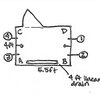Flexible Copper Pipe for Water Heater Installation & Cut-Off
natewall
15 years ago
Related Stories

GARDENING GUIDESHow to Install a Drip Irrigation System
Save time and water with a drip watering system in your vegetable garden — a little patience now will pay off later
Full Story
GREAT HOME PROJECTSHow to Switch to a Tankless Water Heater
New project for a new year: Swap your conventional heater for an energy-saving model — and don’t be fooled by misinformation
Full Story
GREEN BUILDINGHouzz Tour: Going Completely Off the Grid in Nova Scotia
Powered by sunshine and built with salvaged materials, this Canadian home is an experiment for green building practices
Full Story
DOORS5 Questions to Ask Before Installing a Barn Door
Find out whether that barn door you love is the right solution for your space
Full Story
HOME OFFICESQuiet, Please! How to Cut Noise Pollution at Home
Leaf blowers, trucks or noisy neighbors driving you berserk? These sound-reduction strategies can help you hush things up
Full Story
KITCHEN DESIGNKitchen Sinks: Antibacterial Copper Gives Kitchens a Gleam
If you want a classic sink material that rejects bacteria, babies your dishes and develops a patina, copper is for you
Full Story
BATHROOM DESIGNBathroom Details: Show Off Your Sink Line
You heard right. Exposed sink traps have gone stylish, with more materials and matching fittings than ever
Full Story
GREEN BUILDINGOff the Grid: Ready to Pull the Plug on City Power?
What to consider if you want to stop relying on public utilities — or just have a more energy-efficient home
Full Story
LIFE6 Ways to Cool Off Without Air Conditioning
These methods can reduce temperatures in the home and save on energy bills
Full Story
KITCHEN DESIGNHave Your Open Kitchen and Close It Off Too
Get the best of both worlds with a kitchen that can hide or be in plain sight, thanks to doors, curtains and savvy design
Full StoryMore Discussions








jake2007
User
Related Professionals
North New Hyde Park Handyman · Fullerton Kitchen & Bathroom Remodelers · Hopewell Kitchen & Bathroom Remodelers · Bay Shore Kitchen & Bathroom Remodelers · Apex Kitchen & Bathroom Remodelers · Auburn Kitchen & Bathroom Remodelers · Fort Myers Kitchen & Bathroom Remodelers · Idaho Falls Kitchen & Bathroom Remodelers · Omaha Kitchen & Bathroom Remodelers · Terrell Kitchen & Bathroom Remodelers · Waukegan Kitchen & Bathroom Remodelers · Weston Kitchen & Bathroom Remodelers · Middlesex Kitchen & Bathroom Remodelers · North Chicago Kitchen & Bathroom Remodelers · Ridgefield Park Kitchen & Bathroom Remodelerspjb999
lazypup
natewallOriginal Author
lazypup
natewallOriginal Author
lazypup
jakethewonderdog
jakethewonderdog
lazypup
jake2007
jake2007
natewallOriginal Author
chris8796
jake2007
chris8796